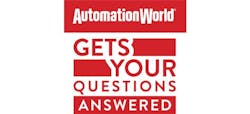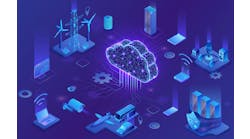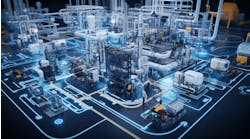See the video and article related to Weidmüller's release of u-OS at Pack Expo 2023.
TRANSCRIPT
David Greenfield, Automation World
Welcome to the Automation World Gets Your Questions Answered podcast where we connect with industry experts to get the answers you need about industrial automation technologies. I'm David Greenfield, editor in chief at Automation World and the question we'll be answering in this episode is: Are open systems reliable enough for industrial IoT?
And joining me to answer this question is Ken Crawford, senior director of automation at Weidmüller USA, a supplier of industrial connectivity and electronics technologies such as terminal blocks, connectors, cabling, IO controllers and power supplies. So thanks for joining me today, Ken.
Ken Crawford, Weidmüller USA
Thanks, David. I'm very excited to be here.
David Greenfield, Automation World
Alright, so you know before we get started on our discussion today, Ken, I just wanna update the audience real quick on the origins of the topic for this interview which started when we met at Pack Expo, where Weidmüller was introducing u-OS which is your open operating system designed to handle tasks such as device maintenance and application integration and automated systems. Now for listeners interested to learn more, I've placed a link to that article that I wrote following our meeting, which also features a video of you, Ken, explaining u-OS on the page for this podcast at the automationworld.com site.
Now based on what I learned in our discussion about u-OS, you know I see u-OS as a great example of how integral the use of open systems technologies is becoming across the automation device landscape. And as you know, it wasn't so long ago that the idea of using open systems technology wasn't exactly widely embraced by the industrial engineering community.
So, seeing Weidmüller’s introduction of u-OS really highlighted for me, you know how far the acceptance of open systems use in industrial technology has come. So considering that history of open systems in industry, and that the basis of your new u-OS strategy involves the use of a Linux core, which of course opens up a number of possibilities for users, the fact remains that some users might still be a bit apprehensive about relying on open source software for their operations, because it's openness can be perceived as less secure.
In your opinion, what are the risks of open-source software and automation today and what is Weidmüller doing to mitigate these? And are there any specific benefits you can point to with regard to security and robustness when using open-source software?
Ken Crawford, Weidmüller USA
Sure. That's, that's actually a great question. So, umm, you hit it on the head a little bit when you mentioned that open-source software is perceived or the perception because it's open lends itself a little bit less secure. But you know, just because hackers can't see the source code doesn't mean that it's more secure by any means, and by some estimates, 90% of the industrial community uses some form of open software today.
And in my opinion, open-source software is that you have is with open-source software. You have the largest developer community authoring, contributing and patching the Linux based OS as well as the other open-source platforms like Python and Node-Red.
At last count, the Linux Foundation estimated the number of developers to be over a million. So a closed or proprietary developer, they can't achieve that level of creative support. Also, because of the openness, and because you will have four players, we engage with communities and we have partnerships and tools that alert us to that, provide us with alerts for any vulnerabilities that may be present as well as help us rapidly our patch, our solutions and also with that level engagement we are seeing an explosion of unique and creative open source solutions that are more flexible and extensible than any kind of closed counterpart could possibly be.
David Greenfield, Automation World
So you know Weidmüller advertises u-OS as an open Linux based operating system as I mentioned earlier you know, but not every automation application needs that level of openness. And of course, not every engineer is comfortable with Linux, so considering that, do you see it as being a good fit for a broad range of industrial automation applications?
Ken Crawford, Weidmüller USA
Yeah, certainly. Linux has come a very, very a long way since the beginning of just a command line structured language. But at the same time, Weidmüller sees that the Linux partitions and the Linux piece can be a little bit more difficult for people that engineers that aren't maybe as a IT literate as a typical Linux administrator would be. That's why we've really abstracted a lot of the Linux portions from the user interface so that you really don't have to understand or know Linux.
So Weidmüller provides powerful tools and we provide applications that limit the need for the user to interact directly with our OS, thereby extracting the need for the user to have really any interaction with Linux at all. And this is a key benefit of the product.
Another benefit is that u-OS enables OEMs to run third party applications that can coexist on the controller and provide an enhanced functionality of the controller. For instance, we support a platform called AnyViz which provides condition monitoring, visualization and cloud connectivity right out of the box.
These are open-source platforms that are supported on Linux now and make it very easy for us to load and utilize. So it makes it a very flexible and extensible platform without really the need for in-depth software development or in depth knowledge of the platform itself. You just take these modules much like an application, load it on our containerized OS and you can run that application and all the and dependencies and all the drivers and all the applications that are associated with that module. So the ability for the containers to isolate each application running in conjunction with the main control algorithm really provides an isolation barrier that enables the control features to be still deterministic and run your analytics as well as the application running independently in a multi-threaded environment. It keeps it all very safe.
David Greenfield, Automation World
I like that you mentioned that I think that's a key point too about even though Linux is integral to u-OS In that you don't have to be an expert in Linux, and historically that has been something of a requirements with different applications. You know, they were built on Linux and the user or the engineers involved with it needed to be at least somewhat familiar. So that's an interesting approach that it's transparent to the user that they don't need to be an expert in that.
So one other thing, you mentioned on that was about the benefits to OEMs, if you don't mind, I'd like to dive into that a little more deeper beyond the technology issues we've been discussing surrounding open systems use in industry. What about the business side benefits? And you know, since you mentioned OEMs lets you know start with that, you know from an OEMs perspective, how can this be used to expand an OEM's business opportunities?
Ken Crawford, Weidmüller USA
So this platform really provides a big punch in a highly integrated and simplified solution. This this really drives a high feature set at a lower cost, lower cost of ownership, lower cost of a reduced bond cost really because of the OS that is the PLC that runs on a PLC. It also enables you to do a lot more with that OS than just be a PLC, and it does it in a way that simplifies a platform.
So years ago it used to be that if you wanted a platform that was cloud connected, you'd have your PLC platform. But then you'd have to buy a gateway, or you'd have to buy a cellular modem, and then you'd have to buy some kind of firewall device. Today with u-OS, since it is a cloud connected OS, we incorporate a lot of those individual parts and pieces and software modules that reside on the PLC itself. So you get a lot of bang for your buck there with a very reduced BOM cost.
In addition, you know since u-OS is built from the ground up, it's really built as a connectivity platform that allows a high level of this integration and adoption for many of the Industry 4.0 benefits, and this is all in a PLC that offers traditional discrete and process level control, as well as providing a state of the art VPN level security.
A missing piece that a lot of companies still don't have for the remotely deployed assets. And that is the idea of fleet management and edge management where you can remotely administer and control and maintain, diagnose, troubleshoot and individual edge device on on your platform as well as all of your remotely deployed devices. So fleet management allows you one really central location, one single pane of glass to see how your machines are operating, what the health of those machines are, if they're online, offline and really get a very quick glimpse of how well your fleet is performing.
David Greenfield, Automation World
Yeah, that whole idea of fleet management or equipment as a service from an OEM point of view, that's a that's definitely been a game changer in the OEM industry over the past few years. And you know, we see no signs of that slowing down. And in fact, it seems to really just be getting started.
So that's a good point there, you know, and following on that, you know from our discussion there on the OEMs, what about from an industry end user point of view at a manufacturing or processing facility, you know, how can these kind of technologies help their operations?
Ken Crawford, Weidmüller USA
So let's take problem detection is an example. So with US's ability to host and run third party applications, imagine installing a data aggregation application alongside Codesys on a PLC with the ability of inherit that aggregation in a PLC. The OEM can continuously gather metric information about their remotely deployed product in a way that enables them to see and detect problems and trends in their equipment.
So you have, you know, basically a your core control algorithm that's running your piece of equipment and then you could just load a third party application that maybe is an analytic that does it really good at problem detection and that analytic can coexist with a control algorithm collecting data, sending that data up into the cloud, allowing you to see trends in your equipment portfolio to be able to detect early problems and rectify those problems as well as optimize your program remotely and update your program. In a way that you can address those problems locally at the edge.
And with detection comes prediction and with prediction that company can better determine issues before they become downtime events and also provides them with solution intuition that puts the right part on the truck before they deploy the site. Resources can cover more customers, more territory, and it results in a lot less wasted time and money for the company.
David Greenfield, Automation World
You know, digging a bit deeper into the industry workforce issues that you mentioned there, you know which is something both end users and OEMs are facing you know, can these open source technologies help address the loss of in-house expertise as boomers retire and greater numbers and also address new workforce trends around remote work and employee retention?
Ken Crawford, Weidmüller USA
Definitely. I think the exodus of expertise with the controls engineering field now entering the retirement ages that a lot of people, a lot of companies are, are seeing that as an issue in many industries, are seeing their workforces retiring. And with that, the exodus of decades of experience and that intellectual property knowledge, you know, companies are now finding that text and engineers like could locate a problem based on experience or even listening to a piece of equipment. And that history is no longer available. Yeah, you know, with the introduction industry 4.0 comes in, comes in handsets through more intelligent machines through data gathering and whatnot, capable of telling you where it hurts. But with those insights require a broader sensor deployment as well is a highly trained workforce.
Normally you can get more information about your machine, but it costs a lot more money and time because you have to outfit that machine with a bunch of sensors and what not to bring that data back.
So in an environment where resources learn and sprint for high wages and with little company loyalty, it's imperative that the companies employ a technology that's easy to learn is easily configured and operates some really with low technology overhead and is expertly supported with a team of central control engineers.
u-OS offers the ability to remotely log in, traverse the solution diagnosed and update the control applications from a central location, and can even be accessed by Weidmüller tech support if needed.
This lessens the impact for resource constrained companies and opens up the possibility for remote work staff to continue to add value remotely instead of having to go into work or having to go onsite. So really having these connected assets with all the tools necessary to access and run them is really what the u-OS brings to the table.
David Greenfield, Automation World
Alright, so last question, Ken, you know we've talked about open systems technologies in industry in general and we've talked about u-OS. You know very specifically as it pertains to both OEMs and end users, but can you give us a few examples of companies in different industry verticals that have used these open-source technologies to actually digitally transform their operations?
Ken Crawford, Weidmüller USA
We've already mentioned a bit about combining open-source applications with an established control algorithm like Codesys to allow you to quickly adopt known, tested solutions to solve problems without adding additional hardware components.
For instance, an oil and gasoline company needed to add tank monitoring, for instance, because what they do is they put a chemical in to control anti data put anti foaming agent in tank so that they can keep that oil flowing when it's moving and they find that they can't really modify a cabinet because these cabinets are certified. So really you OS gives them the opportunity to they can find a local vendor with a local sensor, a tank level sensor and then actually run that that that company's application. That interfaces to that sensor alongside of the control algorithm and connect that to the cloud remotely. So really in the control cabinet, there isn't necessarily a need to modify or add components. You can just connect to an application that runs coincidentally with your control algorithm and bring that data back to the cloud so that the customer can do automatic inventory, for instance, on those anti flow agents.
Another example would be a crane company that offers update services for proclaim installations. You know, it's like, you know, these big industrial crane systems are anywhere from 4 to $12 million for a brand new and up, right. So there's a whole industry of of companies that go out there and they update these these crane systems and as many types of crane systems as there are, they're PLC's. And so no two crane systems look exactly the same, and so a lot of them will standardize on like a you control where we can incorporate you remote into that you control and parasitically connect to each one of those design architects architectures and bring back that data with analytics, with data aggregation with that remote access that secure remote access to a central dashboard where really it doesn't matter if there's ten different installations, they all look exactly the same through a single pane of glass and they're represented where the tag maps are represented. Same look and feel for the dashboard.
So when these companies go in and they offer maintenance contracts from remotely, they can log into these devices and they don't have 10 unique different devices that they really have to manage. They can go into a single portal where all of the devices have been configured to look exactly the same from their perspective, and that really simplifies their ability to manage these diverse fleets.
And we do that with u-OS through the u-link portion of u-OS running on our u-control as well as our u-remote parasitically tying into all the sensors so that we're not really doing any of the control in the crane. But we're doing a lot of the monitoring and status monitoring of that crane.
David Greenfield, Automation World
Well, thank you again for joining me for this podcast, Ken. And thanks of course to all our listeners and please keep watching this space for more installments of Automation World Gets Your Questions Answered and remember you can find us online at automationworld.com to stay on top of the latest industrial automation technology insights, trends and news.




